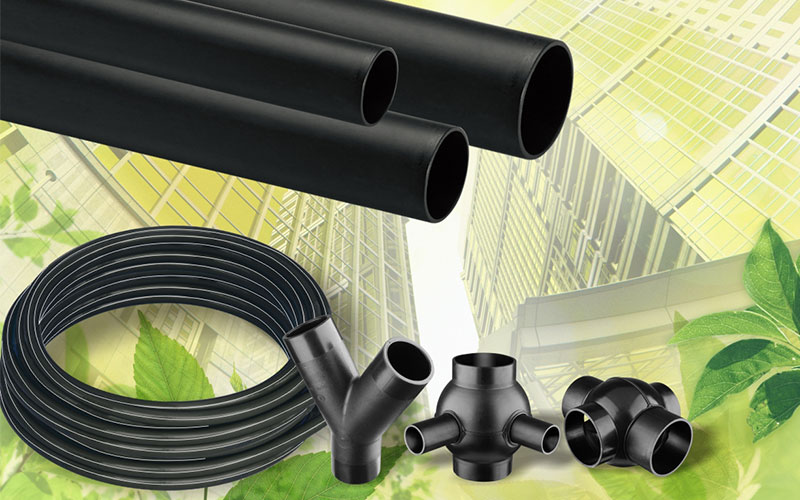How American Plastics HDPE Pipe Manufacturing Maintains Sustainability
Wiki Article
Recognizing the Key Conveniences of HDPE Pipeline for Water and Wastewater Monitoring
Using HDPE pipe in water and wastewater administration presents numerous advantages that warrant factor to consider. Its phenomenal durability and long life-span make it a preferred option for several tasks. In addition, the material's resistance to rust and chemical damages improves its integrity in numerous atmospheres. The benefits extend beyond just long life and resistance. custom hdpe pipe manufacturing Midland TX. Exploring its cost-effectiveness and ecological impact discloses also extra compelling factors for its extensive fostering in modern frameworkOutstanding Resilience and Longevity

HDPE pipeline stands out for its extraordinary longevity and durability, making it a preferred choice in water monitoring systems. Built from high-density polyethylene, these pipelines can hold up against significant pressure and tension, making sure reliable performance gradually. Their robust nature permits them to sustain severe ecological conditions, consisting of temperature level changes and dirt activities, which can cause various other materials to stop working.
The life-span of HDPE pipes typically surpasses 50 years, supplying an affordable solution for communities and markets alike. Additionally, the material's light-weight properties simplify setup, reducing labor prices and durations. This resilience reduces the demand for regular repair work or replacements, better improving its financial charm.
In water monitoring applications, the dependability of HDPE pipes means less disruptions and improved solution connection, making them essential to lasting infrastructure development. The combination of toughness and longevity strengthens HDPE's role as a foundation in efficient water management options.

Resistance to Rust and Chemical Damage
While lots of materials catch rust and chemical damage gradually, HDPE pipes exhibit remarkable resistance, making them ideal for different water monitoring applications. This resilience stems from the molecular framework of high-density polyethylene, which is naturally non-reactive and does not wear away like metals or deteriorate from direct exposure to harsh chemicals. Therefore, HDPE is very effective in settings with aggressive substances, such as wastewater systems that may consist of acids, bases, and natural solvents.
Additionally, HDPE pipelines can endure environmental variables such as soil level of acidity and saline problems, better boosting their viability for varied applications (Pipe Supplier American Plastics Midland). Their capability to keep structural honesty with time lowers the danger of leaks and failures, which is critical in making certain the security and dependability of water circulation and wastewater management systems. The resistance to deterioration and chemical damage significantly adds to the overall efficiency and longevity of HDPE piping options.
Cost-Effectiveness and Financial Advantages
When considering the economic effects of water management systems, the cost-effectiveness of HDPE pipelines ends up being apparent. These pipelines use reduced setup and maintenance expenses compared to typical materials like steel or concrete. Their light-weight nature simplifies transport and installation, causing minimized labor costs. Additionally, HDPE pipelines display a lengthy life expectancy, commonly going beyond half a century, which translates to less replacements and long-lasting financial savings.Furthermore, the resistance of HDPE to rust and chemical page damages lessens the need for costly repair services and substitutes. The pipes additionally support reliable water circulation, lowering energy prices connected with pumping systems. By mitigating leakages and water loss, HDPE pipes contribute to substantial financial advantages for districts and industries alike. Overall, the preliminary investment in HDPE piping can generate considerable monetary returns over the lifespan of the water administration system, making it a prudent go to this site choice for lasting infrastructure advancement.
Environmental Sustainability and Reduced Effect

Convenience and Flexibility in Installation
Because of their distinct residential properties, HDPE pipelines use impressive adaptability and adaptability in installation, making them suitable for a large range of applications. Their lightweight nature permits much easier handling and transport, reducing labor costs and setup time. HDPE pipelines can be bent and formed to fit numerous surfaces and task requirements, which is specifically valuable in challenging atmospheres.Furthermore, their resistance to corrosion and chemical damage permits for setup in diverse settings without the demand for specialized protective finishings. The capacity to fuse joints produces a continuous, leak-free system, boosting the general stability and integrity of the installment. HDPE's versatility additionally suits ground motion, minimizing the risk of damage in areas prone to changing soil. Generally, these attributes make HDPE pipelines not only versatile yet additionally a preferred choice for water and wastewater administration systems.
Regularly Asked Questions
Exactly How Does HDPE Pipe Contrast to PVC in Water Administration Applications?
HDPE pipe uses exceptional adaptability, resistance to corrosion, and resilience contrasted to PVC. Its lighter weight helps with easier installation, while its lengthy life-span decreases substitute costs, making HDPE description a favored choice in water administration applications.What Is the Life-span of HDPE Pipeline Under Typical Problems?
Under typical problems, HDPE pipes can have a life expectancy ranging from 50 to 100 years. Their resilience and resistance to corrosion contribute to their long-term performance in various applications, making them a trusted choice for infrastructure.Are HDPE Pipes Recyclable After Their Solution Life?
Yes, HDPE pipelines are recyclable after their solution life. Pipe Manufacturing Midland TX. They can be refined and repurposed right into new products, significantly lowering environmental effect and promoting sustainability within the industry, making them a green choice for piping servicesWhat Is the Setup Process for HDPE Pipeline?
The installment procedure for HDPE pipes entails site preparation, trenching, pipeline fusion or mechanical joining, backfilling, and stress testing. Proper techniques assure a resilient and effective system for transporting water and wastewater properly.Can HDPE Pipes Be Utilized for Both Drinkable and Non-Potable Water Equipments?
Yes, HDPE pipelines can be used for both potable and non-potable water systems. Their adaptability, longevity, and resistance to corrosion make them ideal for different applications, making certain risk-free and reliable transportation of water in different contexts.Report this wiki page